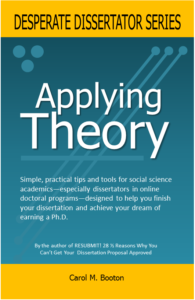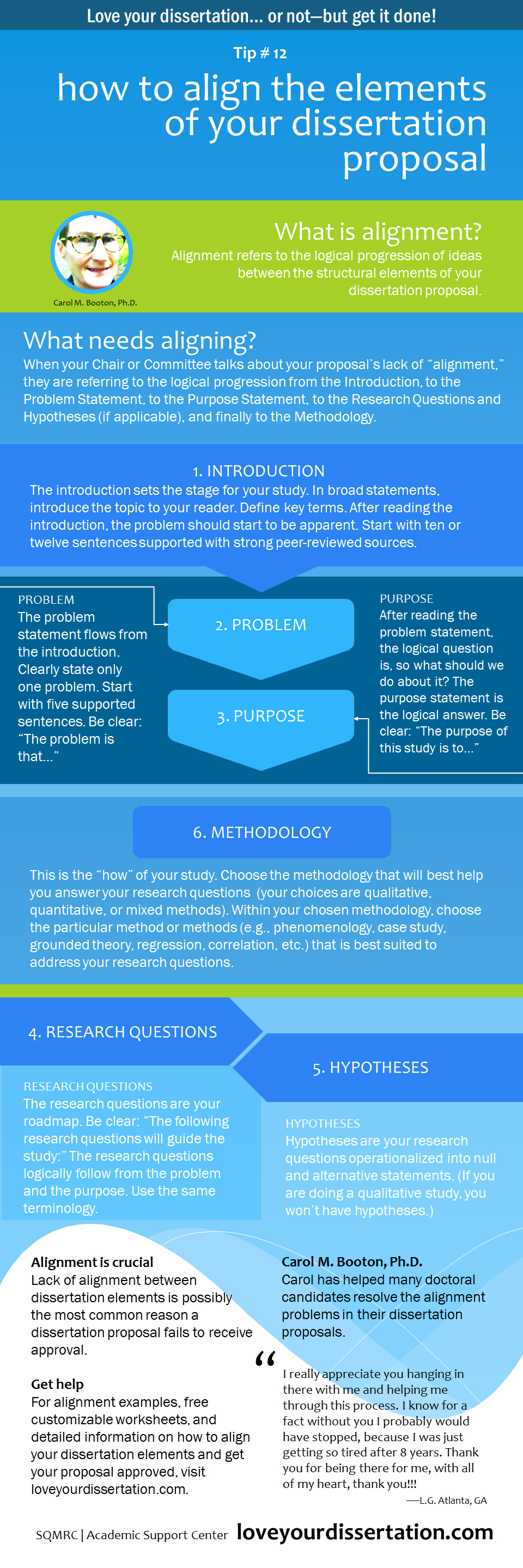
Dissertators often struggle to align the main elements of their research projects. This print or Kindle book offers suggestions from Dr. Carol’s own experience and reveals how other dissertators have aligned their research elements successfully and earned their doctorates.
What is this mysterious thing called alignment?
“The term alignment refers to the logical progression of ideas between the structural elements of the dissertation. When our Chair and committee members talk about achieving alignment, they are referring to the logical progression from the introduction, to the problem statement, to the purpose statement, to the research questions and hypotheses (if we have a quantitative study), and finally to the methodology. Lack of alignment between dissertation elements is possibly the most common reason a dissertation proposal fails to receive approval.”
“The first time I heard the term alignment in relation to my dissertation, I was working on my concept paper (the precursor to the proposal), which had just been rejected by the graduate school reviewers. The biggest problem they identified was that the elements of my paper weren’t aligned. I was confounded. What elements? What alignment? Is that like when Mars aligns with Mercury?”
—Dr. Carol, Aligning the Elements, p. 4
How to align the elements of your dissertation proposal [infographic]
Are you confounded by the challenge of aligning the elements of your dissertation?
In simple language, I explain the basics of aligning the dissertation elements and answer all the questions you were afraid to ask your Chairperson:
- What is this mysterious “alignment” thing?
- What are the elements that need aligning?
- How do I align my problem, purpose, and research questions?
- How do I align my methodology and methods?
- How do I align my assumptions, limitations, delimitations?
- How have successful dissertators aligned their elements?
Download a PowerPoint slide show about aligning the elements of your dissertation
Alignment is possible and you can do it
This brief guide will help you corral your dissertation elements into a logical order. First, we’ll identify the elements we need to align. You are familiar with many of the culprits: The problem, purpose, and research questions are a few. Along the way, I show you what others have done to succeed and offer you some tips from my own experience as a dissertation editor and former dissertator.
Writing in a friendly, nonscholarly manner, I demystify the challenges of aligning the research elements. You will learn that alignment is a fascinating logic puzzle. This small yet powerful book will help you align your elements and achieve your dream of earning your Ph.D.
About the author
Carol M. Booton earned her Ph.D. in the social sciences. Since 2013, Dr. Carol has edited hundreds of dissertation proposals and manuscripts. In the Desperate Dissertator Series, Dr. Carol helps dissertators avoid the mistakes she (and many other dissertators) have made as they struggle to get approvals and finish their dissertations. Aligning the Elements is the second book of the series.
=====================================
Books and resources
Aligning the Elements

In the second book of the Desperate Dissertator Series, I dig into a common problem dissertators face when preparing their proposals: aligning the elements of the dissertation. The elements of the dissertation usually include the problem statement, the purpose statement, the research questions, the theoretical framework, and the methodology and methods. Aligning these elements means ensuring they logically flow from one to the next. Lack of alignment is possibly the main reason proposals are not approved. In this book, I offer some tips to help you align the elements and show what other dissertators have done to succeed (it could be easier than you think).
Print version USD $15.99
Kindle version USD $7.99
Applying Theory

Dissertators often struggle to choose and apply a theoretical framework to their research projects. In this helpful guide, I offer suggestions from my own experience. In addition, I reveal how other dissertators have applied theory successfully and earned their doctorates. Writing in a friendly, nonscholarly manner, I demystify the challenges of applying academic theory to a research project. You will learn that theory is nothing to fear—in fact, we all use theory all the time! With the help of this small yet powerful book, you will learn to master theory and achieve your dream of earning your Ph.D.
Print version $15.99
Kindle version $7.99
Resubmit! 28 ½ Reasons Why You Can’t Get Your Dissertation Proposal Approved

This comprehensive book is the missing link for dissertators who have struggled to get their proposals approved. This indispensable book bulges with insights, suggestions, examples, diagrams, and practical tips, written especially for the online dissertator who may receive little support during the proposal process. I present solutions to address twenty-eight potential reasons why you might be struggling to get your proposal approved. For example, you will learn how to write a clear problem statement, devise research questions and hypotheses, and align the elements of the proposal to facilitate speedy approval. I unlock the mysteries of Word and Excel to show you specifically how to use these tools for your proposals. Over 200 tables and figures show you exactly what to do. As a bonus, you will learn how to design a web-based survey and make a plan for fielding and analyzing the data. In this book, I cover it all to help you overcome obstacles and finish your dissertation.
Free templates and worksheets are available here.
Print version $29.99
Kindle version $9.99


